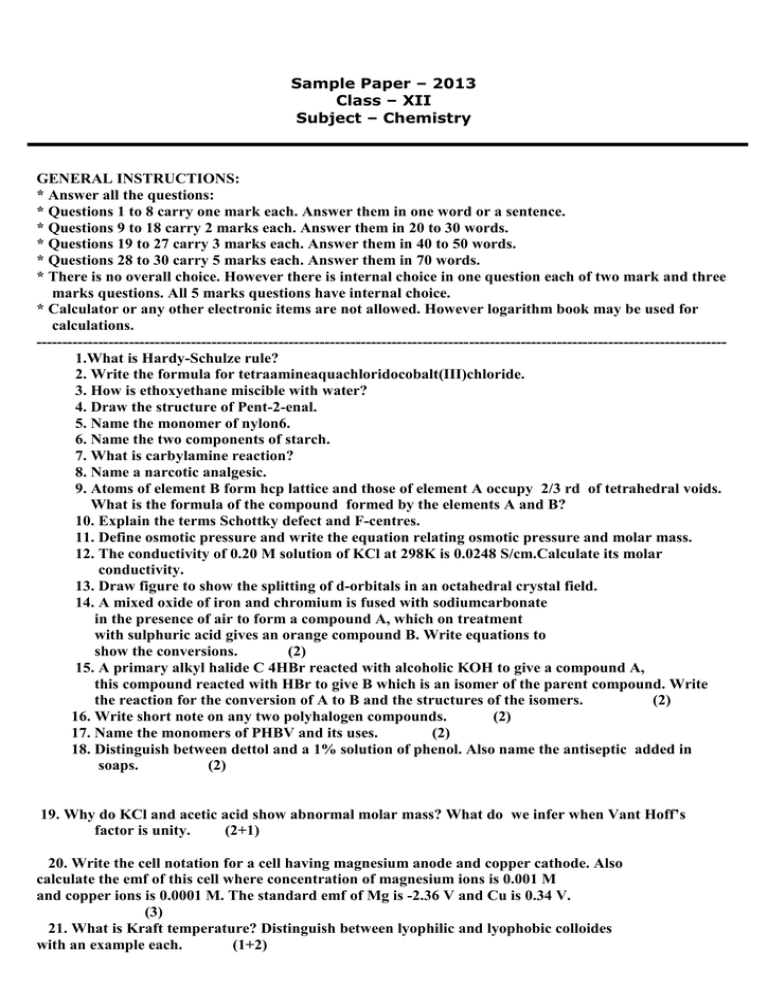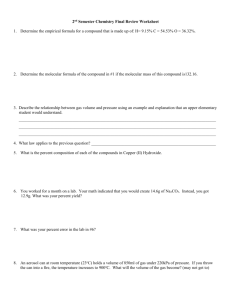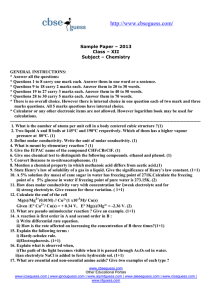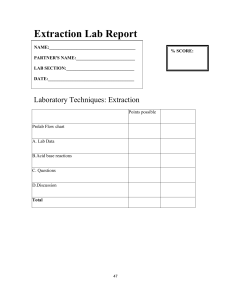Sample Paper – 2013 Class – XII Subject – Chemistry GENERAL
advertisement

Sample Paper – 2013 Class – XII Subject – Chemistry GENERAL INSTRUCTIONS: * Answer all the questions: * Questions 1 to 8 carry one mark each. Answer them in one word or a sentence. * Questions 9 to 18 carry 2 marks each. Answer them in 20 to 30 words. * Questions 19 to 27 carry 3 marks each. Answer them in 40 to 50 words. * Questions 28 to 30 carry 5 marks each. Answer them in 70 words. * There is no overall choice. However there is internal choice in one question each of two mark and three marks questions. All 5 marks questions have internal choice. * Calculator or any other electronic items are not allowed. However logarithm book may be used for calculations. -------------------------------------------------------------------------------------------------------------------------------------1.What is Hardy-Schulze rule? 2. Write the formula for tetraamineaquachloridocobalt(III)chloride. 3. How is ethoxyethane miscible with water? 4. Draw the structure of Pent-2-enal. 5. Name the monomer of nylon6. 6. Name the two components of starch. 7. What is carbylamine reaction? 8. Name a narcotic analgesic. 9. Atoms of element B form hcp lattice and those of element A occupy 2/3 rd of tetrahedral voids. What is the formula of the compound formed by the elements A and B? 10. Explain the terms Schottky defect and F-centres. 11. Define osmotic pressure and write the equation relating osmotic pressure and molar mass. 12. The conductivity of 0.20 M solution of KCl at 298K is 0.0248 S/cm.Calculate its molar conductivity. 13. Draw figure to show the splitting of d-orbitals in an octahedral crystal field. 14. A mixed oxide of iron and chromium is fused with sodiumcarbonate in the presence of air to form a compound A, which on treatment with sulphuric acid gives an orange compound B. Write equations to show the conversions. (2) 15. A primary alkyl halide C 4HBr reacted with alcoholic KOH to give a compound A, this compound reacted with HBr to give B which is an isomer of the parent compound. Write the reaction for the conversion of A to B and the structures of the isomers. (2) 16. Write short note on any two polyhalogen compounds. (2) 17. Name the monomers of PHBV and its uses. (2) 18. Distinguish between dettol and a 1% solution of phenol. Also name the antiseptic added in soaps. (2) 19. Why do KCl and acetic acid show abnormal molar mass? What do we infer when Vant Hoff’s factor is unity. (2+1) 20. Write the cell notation for a cell having magnesium anode and copper cathode. Also calculate the emf of this cell where concentration of magnesium ions is 0.001 M and copper ions is 0.0001 M. The standard emf of Mg is -2.36 V and Cu is 0.34 V. (3) 21. What is Kraft temperature? Distinguish between lyophilic and lyophobic colloides with an example each. (1+2) 22. Give reason:(3) a) Magnesium metal is not used for the reduction of alumina although it is thermodynamically feasible. b) Pine oil is used in froth floatation process. c) Nickel is refined by heating impure nickel in the presence of carbonmonoxide. 23. Explain the following:(3) a) Transition metals exhibit variable oxidation of states. b) Chromium metal has high melting point. c) Transition metals form coloured ions. 24. Distinguish between:- (3) a) Phenol and ethanol. b) Propanol and 2-propanol. c) Why are phenols more acidic than alcohols? 25. a)Fluorine exhibits only -1 oxidation state, but the other halogens exhibit +1, +3, +5 states. Why? (1) b)A pungent smelling gas reacts with excess chlorine to give an explosive compound. Name the gas and compound. (2) 26. a) Write short note on Gabriel phtalimide synthesis. (3) b) Convert aniline to phenol. c) Draw the structure of the zwitter ion of sulphanilic acid. 27. What happens when D-glucose is treated with:(3) a) HI. b) Bromine water. c) Nitric acid. Or Define the following with relation to proteins:a) Peptide linkage. b) Primary structure. c) Denaturation. 28. a) Show that for a zero order reaction, half life is directly proportional to the initial concentration of the reactant, but in a first order reaction, the half life of the reaction is independent of the initial concentration of reactant. (3) b) A first order reaction has a rate constant of 0.00115/s.How long will 5 g of this reactant take to reduce to 3 g? (2) Or a) The rate constants of a reaction at 500 K and 700 K are 0.02/s and 0.07/s respectively. Calculate activation energy. (R=8.314 J/K/mol) (3) b) A reaction is first order in A and second order in B.Write the rate law expression and how will the rate be affected if concentration of B is increased three times? 29. a) What is the basicity of orthophosphoric acid? (1) b) The covalency of oxygen is limited to four. Why? (1) c) Draw the structure of pyrosulphuric acid. (1) d) Noble gases have very low boiling points. Why? (1) e) Write a balanced equation for the reaction between xenonhexafluoride and water. (1) Or a) Ammonia forms hydrogen bonds but not phosphene. Why? (1) b) What led Bartlet to carry out reaction between xenon and platinumhexafluoride?(1) c) Why are halogens coloured? (1) d) Draw the structure of xenondifluoride and give the equation for its preparation. (2) 30. a) Aldehydes are generally more reactive than ketones in nucleophilic addition reactions. Why?(1) b) What is Aldol condensation? Explain with example. (2) c) Explain Cannizzaro’s reaction. (2) Or a) Convert carbondioxide to acetic acid. (1) b) Convert butanal to butanoic acid. (1) c) Convert ethylbenzene to benzoic acid. (1) d) Draw the structure of 4-Chloropentan-2-one. (1) e) Give the product obtained when benzoic acid is treated with conc.sulphuric acid and conc.nitric acid(Nitrating Mixture). ------------------------------------------------------------------







